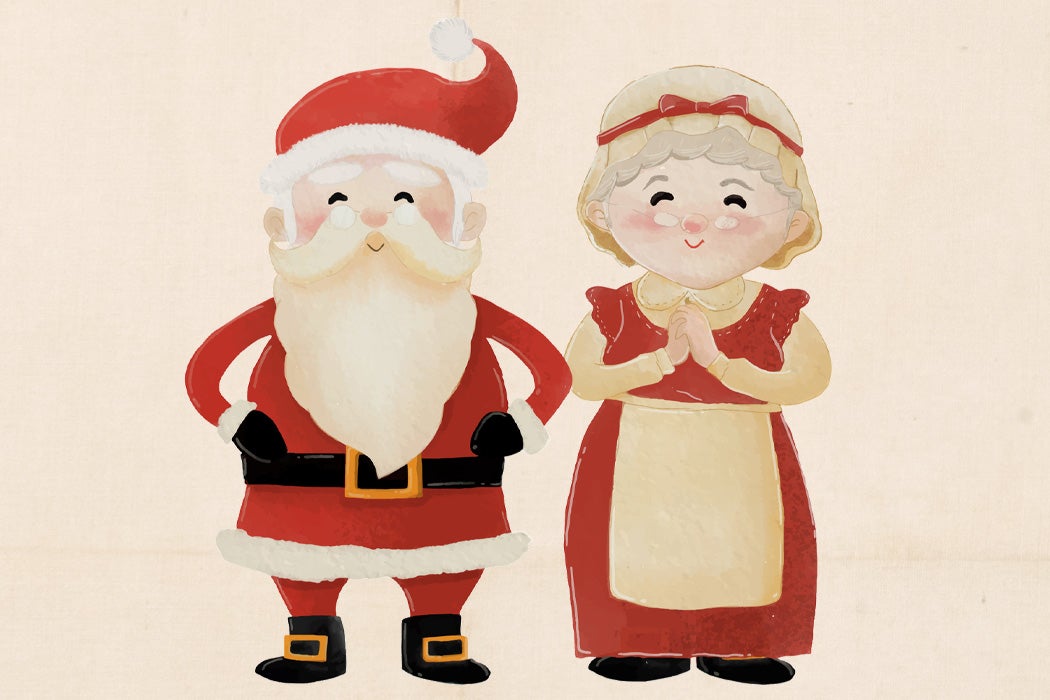Today, we all know how Santa Claus lives—on the North Pole, surrounded by a herd of reindeer, a lot of elves laboring in a highly questionable employment situation, with, of course, Mrs. Claus. But, as art historian Karal Ann Marling writes, Santa was a Christmastime icon for decades before anyone knew he had a wife.
Saint Nicholas has his own long and storied history, but the modern Santa really got his start with Clement Clark Moore’s 1823 poem “A Visit from Saint Nicholas”—aka “The Night before Christmas.” Here Santa has his classic round belly, twinkling eyes, and sack of toys. But, Marling writes, Moore gave no hints about what Santa might do when he wasn’t shooting down and up chimneys on December 24.
In 1866, cartoonist Thomas Nast filled in some of the gaps regarding Santa’s home life, picturing him on the North Pole, sewing doll clothes, trimming trees, and keeping an eye on the children of the world through a spyglass. But Nast’s Santa was apparently a bachelor.
That only changed in the 1880s, when American magazines began publishing stories featuring Mrs. Claus. The first of these, which Margaret Eytinge wrote for Harper’s Young People in 1881, showed Santa’s plump, good-natured wife supervising the baking and candy making at the North Pole. Over the next few years, magazine stories cemented her identity. In 1899, Katherine Lee Bates, author of the words to “America the Beautiful,” published the book Goody Santa Claus on a Sleigh Ride. In a magazine story, Louisa May Alcott also described Mrs. Claus waiting at home for her husband’s return from his global Christmas Eve mission.
Marling writes that it’s no coincidence that Mrs. Claus showed up in the late Victorian era.
“The provision of a Mrs. Claus in the 1880s reflected a certain weary realism on the part of women who wrote for the magazines,” she writes. “Santa Claus create a decent Christmas? they huffed. And how would he do that, all by himself?”
By this time, Christmas in white, middle-class America had transformed from a time of rowdy feasting and drinking to a holiday focused on home and family. Women learned to wrap presents using tissue paper held in place with pins and ribbons and decorated with a sprig of holly. They studied magazine recipes for plum pudding, a definitive Christmas dish, thanks to the influence of Charles Dickens.
Weekly Newsletter
Christmas became fodder for a war of the sexes. In 1910, Good Housekeeping published men’s opinions about the holiday, including this complaint: “Sprigs of holly! Pretty tags! Bah, humbug! Men don’t like presents ‘wrapped’ or ‘fussed’ in tissue paper, ribbons, or tinsel.” Magazine covers showed men as inept holiday shoppers, or depicted excessively competent, bossy women storming through department stores with husbands in tow.
Given the era’s gendered division of shopping and homemaking from public life, Santa might do all the delivery work and boss the elves around, but he couldn’t very well keep a cozy home without Mrs. Claus by his side.
Support JSTOR Daily! Join our new membership program on Patreon today.







